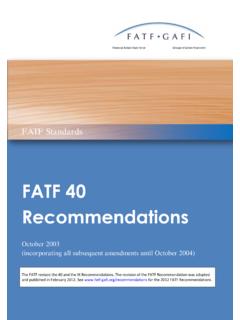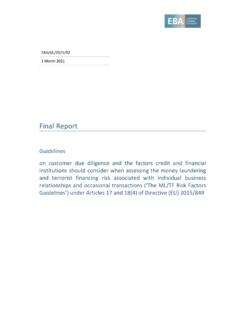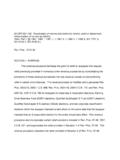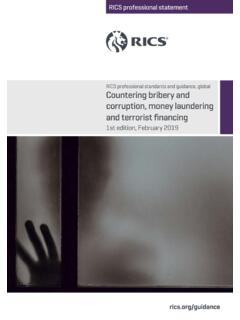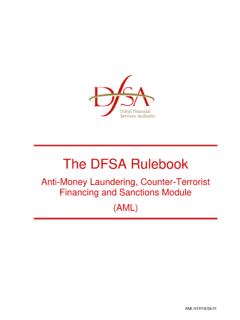Transcription of Anti-money laundering and terrorist financing measures and ...
1 FATF GUIDANCE. Anti-money laundering and terrorist financing measures and Financial Inclusion With a Supplement on Customer Due diligence November 2017. FINANCIAL ACTION TASK FORCE. The Financial Action Task Force (FATF) is an independent inter-governmental body that develops and promotes policies to protect the global financial system against money laundering , terrorist financing and the financing of proliferation of weapons of mass destruction. The FATF Recommendations are recognised as the global Anti-money laundering (AML) and counter- terrorist financing (CFT) standard For more information about the FATF, please visit the website: This document and/or any map included herein are without prejudice to the status of or sovereignty over any territory, to the delimitation of international frontiers and bounderies and to the name of any territory, city or area.
2 The 2013 Guidance on Anti-money laundering and terrorist financing measures and Financial Inclusion was a collaboration with APG and the World Bank. This 2017 edition combines the FATF Supplement with the original 2013. Guidance. Citing reference: FATF (2013-2017), Anti-money laundering and terrorist financing measures and financial inclusion - With a supplement on customer due diligence , FATF, Paris 2013-2017 FATF/OECD. All rights reserved. No reproduction or translation of this publication may be made without prior written permission. Applications for such permission, for all or part of this publication, should be made to the FATF Secretariat, 2 rue Andr Pascal 75775 Paris Cedex 16, France (fax: +33 1 44 30 61 37 or e-mail: Anti-money laundering and terrorist financing measures and financial inclusion With a supplement on customer due diligence CONTENTS.)
3 2017 SUPPLEMENT ON CUSTOMER DUE diligence AND FINANCIAL INCLUSION. Assessing risk and mitigation in a financial inclusion context ..5. Customer due diligence process to support financial 10. Customser due diligence process and digital financial inclusion .. 22. APPENDIX .. 25. EXPERIENCES FROM THE WORLD BANK'S SUPPORT TO FINANCIAL INCLUSION PRODUCT RISK. 25. 2013 FATF GUIDANCE ON Anti-money laundering AND terrorist financing measures . AND FINANCIAL INCLUSION. EXECUTIVE SUMMARY .. 31. INTRODUCTION BACKGROUND AND CONTEXT .. 33. Preliminary remarks .. 33. Scope of the February 2013 Guidance Paper.
4 34. Objectives of the Guidance .. 35. Target Audience .. 36. Status and Content of the Guidance Paper .. 36. CHAPTER 1 STATEMENT OF THE PROBLEM .. 38. What is Financial Inclusion?.. 38. State of Financial Inclusion .. 38. The Diversity of the Financially Excluded and Underserved Groups .. 39. Challenges of Financial Exclusion .. 39. Balancing AML/CFT Requirements and Financial Inclusion .. 41. CHAPTER 2 - GUIDANCE ON ACTION TO SUPPORT FINANCIAL 43. I. Preliminary Remarks .. 43. II. Overview of the Risk-Based Approach of the FATF .. 44. flexibility offered by the FATF Recommendations in proven low risk scenarios: the exemptions.
5 49. FATF Recommendations in the light of financial inclusion objectives .. 53. CONCLUSION .. 75. ANNEXES .. 76. TABLE OF ACRONYMS .. 113. BIBLIOGRAPHY AND SOURCES .. 114. 2013-2017 1. Anti-money laundering and terrorist financing measures and financial inclusion With a supplement on customer due diligence SUPPLEMENT TO THE 2013 FATF GUIDANCE ON AML/CFT measures . AND FINANCIAL INCLUSION. CUSTOMER DUE diligence AND FINANCIAL INCLUSION. FATF AND FINANCIAL INCLUSION. The FATF is committed to financial inclusion. The application of measures that enable more individuals and businesses, especially low-income, unserved and underserved groups, to access and use regulated financial services increases the reach and the effectiveness of Anti-money laundering /countering the financing of terrorism (AML/CFT) regimes.
6 Unserved and underserved people have to be financially active and may be forced to conduct their transactions through unregulated channels when they lack access to formal financial services. 1 Enabling these groups of people to use regulated and supervised channels supports improved consumer protection against fraud, financial abuse and exploitation. It also expands the scope of traceable transactions, facilitating the detection, reporting and investigation of suspicious transactions, thereby reducing overall money laundering (ML) and terrorist financing (TF) risks. Financial inclusion and financial integrity are thus mutually reinforcing.
7 FATF standards require financial institutions to apply appropriate customer due diligence (CDD). measures . However, FATF is also aware that applying an overly cautious, non risk-based approach to AML/CFT safeguards when providing financial services (both at the on-boarding stage or in the context of ongoing relationships) can have the unintended consequence of excluding legitimate consumers and businesses from the regulated financial system. To address this concern, in February 2013, FATF adopted Guidance on AML/CFT measures and Financial Inclusion, updating the guidance it first provided in 2011.
8 2 The main purpose of the 2013 Guidance was to provide support for designing AML/CFT measures that meet the goal of financial inclusion, without compromising their effectiveness in combating crime. The 2013 Guidance also reflected the changes made to the FATF. Recommendations in 2012 3, in particular the reinforcement of the risk-based approach (RBA). The development and application of risk-sensitive and proportionate AML/CFT frameworks are a key step for countries that seek to build a more inclusive regulated financial system, and enable a larger proportion of the population to access appropriate financial services especially the most vulnerable and unserved groups.
9 One of the main financial integrity challenges in a financial inclusion context is the lack of reliable identity documentation and data verification for potential customers. This limitation creates an obstacle to conducting the required level of due diligence . In 2014, the World Bank reported that 1 Collins, Morduch, Rutherford, Ruthven, Portfolios of the Poor, 2009; Financial diaries 2 ml 3 2 2013-2017. Anti-money laundering and terrorist financing measures and financial inclusion With a supplement on customer due diligence 18% of all adults without an account cited documentation requirements to establish proof of identity as an important barrier to account ownership.
10 4 These requirements could primarily affect people living in rural areas or employed in the informal sector ( individuals paid in cash, undocumented migrants), who are less likely to have formal proof of identity or of address, and other checks often completed by banks in the process of verifying an individual's identity. This is more visible in low capacity countries, some of which do not have any national ID infrastructure. However, these challenges may also affect specific groups of people in developed economies, for example asylum- seekers and refugees from higher-risk countries. Financial institutions' concerns about the reliability and robustness of their identity documentation create challenges, but providing these people with access to financial services and products is critical to their full participation in economic and social life, and a door-opener to other services such as basic utilities, housing contracts, education or small business loans.











